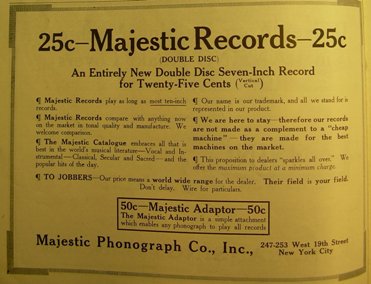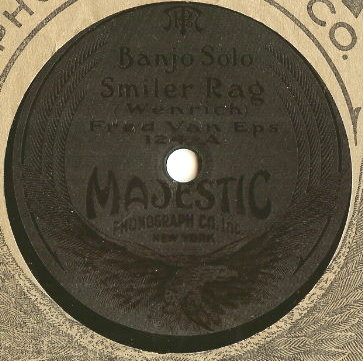

Majestic Record Corporation
The address given in the ad,
In August and September Majestic Phonograph Co., Inc. continued to place ads in TMW looking to add dealers. They also placed an ad in the retail trade publication Dry Goods Economist August 19th issue (Figure 3a). They were making big claims about how easy the records would sell, big profits were to be made, fast delivery, etc. In addition to saying they will play as long as most 10" records there is now the statement that they play for three minutes. In the August TMW ad (Figure 3.) there is still no mention of when the records would be available. Perhaps there is a hint in the following statement from the ad.
"It's a changed situation. The demand for a lower priced record is even greater than it was a year ago. In about three months or sooner the demand will be many times greater than it is today. Probably the greatest factor in bringing about this change will be the Majestic Record."
Interesting prediction on the timing of the great demand for lower priced records in three months as the first announcements in the record bulletin in TMW wouldn't show up until November, three months later.
However, in the August 19th Dry Goods Economist ad and the September TMW ad (Figure 4.) they mention "large quantities available for immediate delivery." They also claim "30 new titles each month." While there are no statements here about whether the records were ready it would appear they were and records were being shipped to customers. According to the deposition of Albert J. Appell, Treasurer and attorney for Majestic Phonograph, they had been advertising and shipping product prior to the agreement with Majestic Record, which took place in early October. Only one customer is mentioned, Strobel & Wilken.
At some point in this time period of late August, 1916 Jacques M. Kohner started talking with Robert C. Shaal, General Manager of Majestic Phono, to become Sales Manager. Shaal had recently come to Majestic from Safety Car Heating & Lighting Co. in
Also in September Majestic Phono advertised Dry Goods Economist again (Figure 4b). The ad makes similar claims as the TMW ads but is a full page. The interesting point is that this is the September 16, 1916 issue and it is known that Majestic Phono and Majestic Record were splitting the cost of the advertisements in Dry Goods Economist. There were two ads, the other would show up in November and the cost for the two of them was $293.883. So it is likely there was some communication and agreement of a future working relationship early in September.
On Septemer 22, 1916 the three directors of Majestic Record Corporation, David Green, Richard V. Schoenfeld and Jerome C. Reis signed their Incorporation papers (Figure 5). The announcement for Majestic Record came out in the September 26, 1916 New York Times (Figure 6) as well as on page 22 of the October issue of Talking Machine World.
The amount of capital stock in the new company was $10,000. However, they were to begin business with capital of $2,750. Shares were split to David Green (100), Richard Schoenfeld (100) and Jerome Reis (75).
The address given in the New York Times announcement of
On the certificate of incorporation the first paragraph for the purpose of the corporation is listed as follows: "To purchase and sell all kinds of phonograph records and phonographs, and kindred commodities, both imported and domestic, and to manufacture phonographs, phongraph records, and kindred commodities, and to do and perform any of the above in the same manner as a natural person might or could do, it being expressly understood that none of the objects for which this Company is incorporated as above enumerated, shall in any wise be deemed to limit the business of this company."
On October 5, 1916 the two companies entered into an agreement whereby Majestic Record would be the exclusive sales agent within the
In October, Majestic Record went all out and took out a full two page ad in TMW (Figure 7.) on pages 68 and 69. In this ad they now begin to use the name of the sales company, Majestic Record Corporation, with offices at
The bill for this ad and the two Dry Goods Economist ads went to Majestic Phono and through January still had not received payment from Majestic Record for their share of $270.173.
Also in the October issue of TMW, on page 70, was a small article announcing the organization of the new company (Figure 8.). Most of the information from the ad is in the article. The article states "Several appointments in the new corporation are now being considered and will be announced shortly."
Tensions already started to build in October between the two companies3. Record orders for October were quite low, averaging 289 per day (417 per day on days in which an order came in) or a total of 7515 from October 6th to 31st 3. Albert Appell allegedly continually asked Jacques Kohner how many salesmen he had in the field and what territories were covered. Kohner was evasive eventually telling him 15 salesmen but never revealing territories (Kohner admitted to nine salesmen in his deposition). Appell complained that he even couldn’t find records to purchase in nearby towns like
November 1916 finally brings the announcements in the record bulletin of TMW for the first record releases by Majestic on pages 117 and 118. The bulletin shows 50 records, all 7 inch (see Discography link). No 9 inch records are announced yet. However, in this same issue is another ad (Figure 9.). In the ad it announces the 9 inch record - "This new record is nine and a quarter inches in diameter, plays four and a half to five and a half minutes, and retails with full margin at 50c. Now ready for delivery." They are still making some bold claims about their quality and how they are dominating the popular priced record field. They do add one interesting technical note in that the records are cut at 165 threads to the inch, much higher than the standard 78 rpm disc.
There was also the ad in the November 18, 1916 issue of the Dry Goods Economist, page 40 and is almost identical to the TMW ad (Figure 9a).
In the December issue of TMW there are two articles, another ad and 35 new records announced in the record bulletins on page 117. There were 15 new seven inch records and the first 20 nine inch records.
In the article of page 94 (Figure 10.) it announces there are new jobbers of Majestic records. They mention Jaques M. Kohner, as the new General Manager. The article states that after a ten day trip on December 11 to the Middle West Mr. Kohner had made arrangements with a number of new jobbers to distribute the Majestic records in
The article on page 98 (Figure 11.) talks about their new catalog being out and that there is new marketing material for store owners. It also states "orders for the last two months have been very heavy, but shipments have been made promptly, according to the management, and they look for a still heavier demand during the holidays." The catalog (Figure 12.) was a small booklet and Majestic Record allegedly had 50,000 printed, a number which Majestic Phonograph disputed. Regardless, one was supplied as evidence. They also had a window hanger printed up (Figure 13.) and a large advertising sheet that was approximately 12”x24” showing the latest releases. One copy was in with the court documents but I was not able to make a copy.
The ad on page 100 (Figure 14.) touts the "Supremacy of Majestic Records in the Popular Priced Field Is Undisputed." This would be their last ad in TMW.
Actual sales for November were 20,450 records and in December were 31,144 (1,003 per day or 1245 per day only counting days for which an order was received). The best day was December 5th with a total of 4716 records ordered. The only sales noted after that in testimony were the first two days of January totaling 2,8863. Even their best month to date, December, came no where near their contracted amount of 6,000 records per day. However, it did approach the daily output of the manufacturing plant. This came up in discussions between Robert Shaal and Jacques Kohner and allegedly Shaal told Kohner not to give orders that exceed the capacity of the daily output. This, of course, was denied by others at Majestic Phono. On October 16, 1916 it is noted that there were 50,000 records in stock ready for shipment. On January 6th there were about 35,000 ready with another 16,000 or 17,000 not ready yet5. So it was possible for Majestic Phono to begin to handle orders greater than their daily output with upwards of 50,000 records in stock and with another press coming on line shortly. It is unknown how many records were sold prior to October 6, 1916 and after January 3, 1917.
Through this time period of October through December and into early January they had four presses going. Three were dedicated to the 7 inch records which were pressed two at a time. One machine was dedicated to 9 inch records and were only pressed one at a time. The best production rate during this time was about 1400 per day for all 4 presses. For 9 inch records 200 per day was an average while it was 400 per day per machine on the 7 inch records. A fifth machine was installed around January 6, 19175. According to a letter from Robert Shaal to Jacques Kohner after Shaal left the employment of Majestic Phonograph he stated that production should have been 100 per hour for the 7 inch records but never exceeded 550 records per 8 hour shift, claiming production problems.